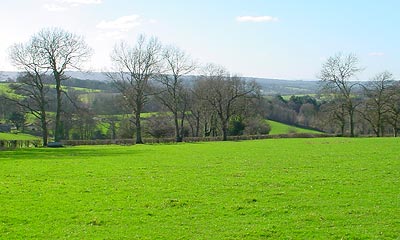West of Stevenage - a black day for the Green Belt
Next time you travel along the A1(M) past Stevenage, just glance at the woods, green fields and hedgerows to the west of the motorway. Welcome to West of Stevenage. All this, including the long, straight hedge marking the line of the Roman road to St Albans, is still in the Green Belt Land. But the decision has now been made for this to become probably the largest building land site in the East of England. The battle to save the Green Belt, (waged for almost ten years) is all but lost.
The news broke on 20th October, when the Deputy Prime Minister released the Inspector's report into the two planning applications for the site, and announced his intention to grant outline planning permission for the scheme based on 3,600 dwellings.
It was at the end of 1995 that Stevenage Borough Council first offered to solve the problem of meeting the County Council's housing targets. They proposed a massive expansion of Stevenage across the A1(M) motorway into the Green Belt, and onto land that was not even in Stevenage, but formed part of North Herts. They proposed an initial phase of 5,000 houses, with a possible second phase taking the total to 10,000. They argued this scale of building was necessary to justify the infrastructure costs of linking the site with the rest of Stevenage.

All who knew the area were dismayed by the proposal. CASE (Campaign Against Stevenage Expansion) was formed to fight it, which it did with overwhelming public support. Three rounds of public consultation and conclusive evidence against the scheme at an Examination in Public, were all overruled in a highly political vote in County Hall incorporating the scheme into a new County Structure Plan in 1998. And that has led to where we are today.
The scheme was never incorporated into a revised Local Plan for North Herts as it is noncompliant with PPG3; it failed the sequential test of building on brownfield sites first. The developers therefore decided to force the issue, putting in planning applications for two schemes, one for 3,600 dwellings and the second for 5,000. These were inevitably "called in" to be determined by the Office of the Deputy Prime Minister, and a public inquiry was held in early 2004.
The Inspector's report remained at the ODPM for almost a year without its contents being revealed to the public. It is only now that we know the Inspector recommended going ahead with the smaller of the two schemes. He admitted the scheme would be damaging, but that exceptional circumstances were justified in meeting Hertfordshire's housing needs.
The Deputy Prime Minister in accepting the Inspector's recommendation has laid down no fewer than 51 conditions to be fulfilled. These include a planning obligation in respect of transport facilities and infrastructure that must be submitted within three months, and will no doubt be difficult for the developers. But it can only be concluded that with the DPM giving the green light to this unsustainable and car dependent development, the developers will do everything necessary to ensure that outline planning permission is confirmed.
After that, detailed planning permission will inevitably follow. With the 3,600 dwellings worth perhaps £0.75billion, the developers will not let this slip from their grasp. And of course, the 3,600 must be seen as the first phase towards something larger, perhaps even the 10,00 houses originally envisaged by Stevenage Borough Council ten years ago.
But will even the 3,600 dwellings actually contribute to Hertfordshire's housing numbers by 2011 remains? The last thing the developers would want is for such a glut of housing to result in lower prices (despite all the intentions of the Barker Report). And won't all the builders be busy elsewhere in 2011?
John Davies, Hitchin society (Winter 2005)
